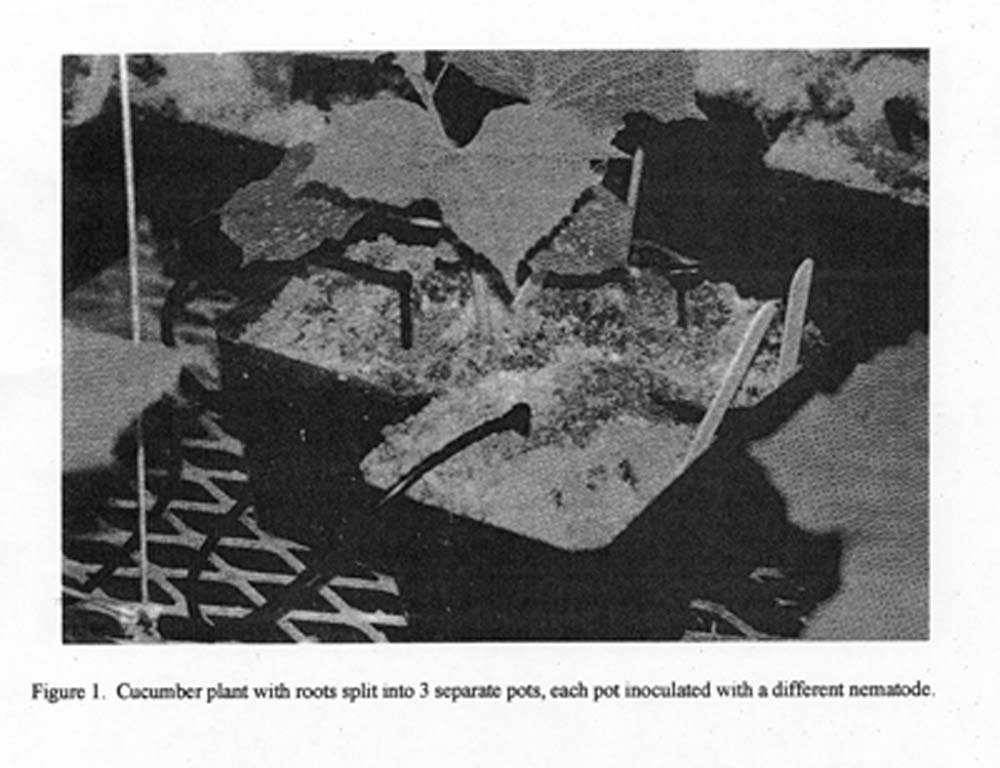Cucurbit Genetics Cooperative Report 18:29-30 (article 13) 1995
S. Alan Walters and Todd C. Wehner; Kenneth R. Barker
Dept. Horticultural Science, North Carolina State University, Raleigh, NC 27695-7609; Dept. Plant Pathology, North Carolina State University, Raleigh, NC 27695-7616
Currently there are no cucumber cultivars that have resistance to the root-knot nematodes that are detrimental to cucumber production in the southeastern United States: Meloidogyne arenaria, M. javanica and M. incognita. We have identified resistance to several root-knot nematodes in Cucumis sativus var. hardwickii line LJ 90430 (2). That line has resistance to M. arenaria races 1 and 2, and M. javanica. We have started a breeding program to develop inbreds resistant to three nematodes. Thus, it is necessary to test each plant for three nematodes.
In order to overcome that problem, a split-root technique was developed in which the root system of each plant was split equally into three 10-cm plastic pots filled with a 1:1 mixture of steam-sterilized sand and soil (Fig. 1). That permitted us to evaluate segregating material for three root-knot nematodes simultaneously.
Materials and Methods. A greenhouse study was conducted to compare our standard (single-root) technique with the split-root technique. For the split-root technique, seeds were planted in trays containing vermiculite, then transplanted two weeks later into pots. Two weeks after transplanting, pots were inoculated with 5000 eggs of the respective root-knot nematode (M arenaria races 1 or 2, or M. javanica) utilizing a 1% Na0Cl solution to extract eggs from infected roots or ‘Rutgers’ tomato (1). With the standard technique, cucumber seeds were planted into 5-cm peat pots containing Metromix 220. Peat pots with plants at the 2 to 3 leaf stage were then planted directly into 15-cm diameter plastic pots containing a 1:1:1 mixture of soil:sand:peat. Pots were watered using drip irrigation and fertilizer injection. That watering system minimized pot to pot contamination of nematodes in the split-root treatment. Three NCH1 families being developed for root-knot nematode resistance were used to compare the split-root technique with the standard transplanting technique. Each treatment combination had 10 replications. The number of days to first flower and vine length (cotyledon to shoot apex) at three and six weeks were determined.
Results. Plants grown with the split-root technique were slower to flower, and were stunted in growth at both three and six weeks compared to plants grown with the normal technique (Table 1). Transplant shock was occurring more with the split-root technique, probably as a result of roots recovering from exposure to desiccation in the soil during transplanting. It is unlikely that the delay was due to nematodes, since the plants had been inoculated only one week before the first vine lengths were recorded.
A 3 to 8 day delay in flowering date occurred with the split-root technique (Table 1). Vine growth at 3 weeks was significantly reduced in the split-root technique compared to the normal technique. By the 6th week, plants in the split-root technique had recovered, but vines were shorter than when grown with the standard technique. Plants eventually recovered in the split-root treatment, and formed large fruits with viable seeds. Therefore, the cost associated with the split-root technique was a suppression in plant growth and a delay in flowering. That resulted in fruit being harvested 1 to 2 weeks later in the split-root technique compared to the standard technique. However, the delay is manageable, and the extra information on nematode resistance well worth the trouble.
Figure 1. Cucumber plant with roots split into 3 separate pots, each pot inoculated with a different nematode.

Table 1. Comparison of the split-root technique in three families of cucumbers that were transplanted normally for days to first staminate flower and vine length at 3 and 6 weeks after transplantingz .
Technique |
Family |
Days to first Flower |
Vine length (cm) 3 weeks |
Vine length (cm) 6 weeks |
| Standard | NCH1-1 | 35 | 32 | 178 |
| NCH1-2 | 36 | 22 | 154 | |
| NCH1-3 | 35 | 35 | 191 | |
| Split-root | NCH1-1 | 42 | 4 | 93 |
| NCH1-2 | 44 | 4 | 76 | |
| NCH1-2 | 38 | 8 | 123 | |
| LSD (5%) | 2 | 4 | 14 |
zData are means of 10 replications of 1 S4 plant each.
Literature Cited
-
- Byrd, D.W., Jr., H. Ferris and C.J. Nusbaum. 1972. A method for estimating numbers of eggs of Meloidogyne spp. in soil. J, Nematology 4:266-269.
- Walters, S.A., T.C. wehner and K.R. Barker. 1993. Root-knot nematode resistance in cucumber and horned cucumber. HortScience 28:151-154.